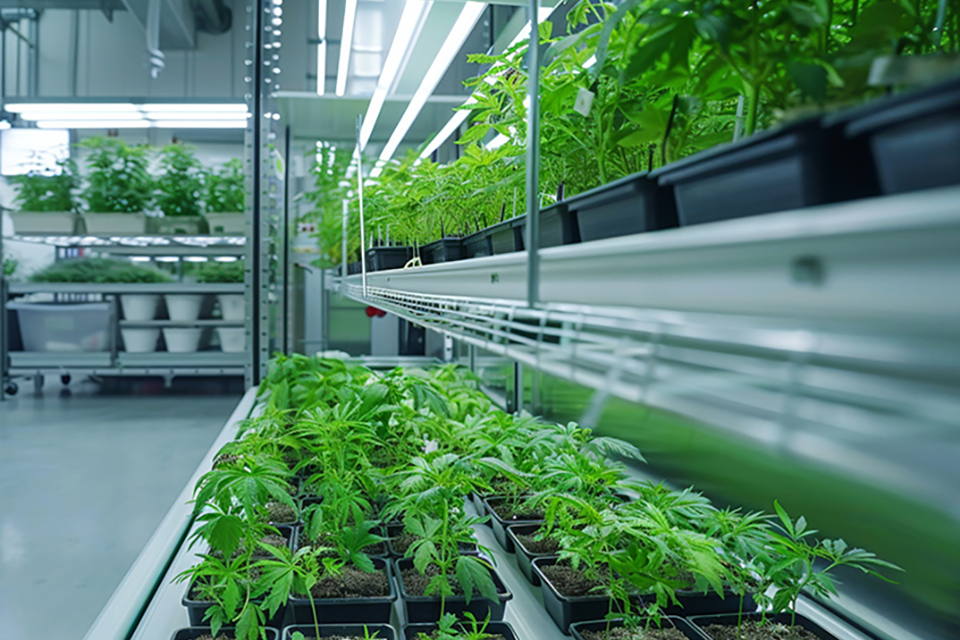
Vertical growing, a method of cultivating plants in stacked layers instead of spreading them out horizontally, has been gaining popularity in the cannabis industry in recent years. As home growers seek more efficient and sustainable ways to produce their own cannabis, the question arises: is vertical growing the future of cannabis cultivation? We’re breaking down the ins and outs of vertical growing and what it can offer home growers. Learn any challenges that might arise from implementing it and discover predictions about how the industry might or might not change to accommodate this style of growing.
Advantages of Vertical Growing for Cannabis
Vertical growing presents a myriad of benefits that may make it an appealing option for home growers. These advantages range from space utilization to resource efficiency, and potential yield enhancements.
Maximizing Limited Space for Home Growers
The primary advantage of vertical growing is the ability to maximize limited space. Instead of spreading your cannabis plants out on a horizontal plane, you stack them in layers. This not only allows for more plants to be cultivated in a given area but also offers an innovative way to deal with small-spaced apartments, urban areas, or places where land is scarce or costly.
Efficient Use of Resources: Water, Light, and Nutrients
Vertical farming also ensures the efficient use of water, light, and nutrients. By stacking plants vertically, growers can distribute light and water more evenly across all plants, reducing waste and enhancing growth. Similarly, nutrients can be better managed and distributed, as the vertical setup allows a closed system where any excess nutrients can be easily recaptured and reused.
Potential for Higher Yields in Home Cultivation
Another benefit of vertical growing lies in its potential to boost yields. The ability to cultivate more plants in a confined space, coupled with efficient utilization of resources and a uniform distribution of light, water, and nutrients, leads to an environment conducive for cannabis plants to thrive. As such, home growers may witness an increase in their yields, making vertical growing a potentially lucrative option for them.
Challenges and Considerations
Despite the many advantages, adopting a vertical growing system may present certain challenges, especially for home growers. Many of these relate to cost and the ability to control your growing environment, not to mention regulations around cannabis growing.
Technical Requirements and Investment for Home Growers
Firstly, creating a vertical growing system requires a certain level of technical knowledge and initial investment. It involves setting up specialized lighting and irrigation systems, understanding the plant’s nutrient requirements, and calibrating the timing of light exposure. Therefore, home growers will need to invest time and resources in learning and setting up the system.
Environmental Control and Monitoring in a Home Setting
The efficiency of a vertical growing system also relies heavily on proper environmental control. Home growers need to constantly monitor and adjust variables such as temperature, humidity, and light exposure to maintain optimal growth conditions. Any disruption in these factors can lead to detrimental effects on the plant’s health and yield.
Regulatory Considerations for Home Cultivation
Home growers should be mindful of the regulatory considerations in their respective geographies. Some regions may have strict guidelines regarding the amount of cannabis a home grower can cultivate, which might affect the viability of a vertical growing system.
Future Potential of Vertical Growing
The future of vertical growing in the cannabis industry looks promising, largely due to emerging trends and technological advancements. With the amount of space for growing becoming more scarce for most, this helps to make vertical growing that much more viable.
Emerging Trends and Technological Advancements
Modern technology is making vertical growing more accessible to home growers. Innovations such as LED grow lights, automated climate control systems, and smart irrigation tools are simplifying the vertical growing process.
Potential Impact on the Home Cannabis Cultivation Market
Vertical growing could potentially revolutionize the home cannabis cultivation market, as it enables growers to cultivate more plants in less space, leading to increased yields and efficiency. Its ability to conserve resources also aligns with trends towards sustainability, further fueling its adoption.
Comparison with Traditional Cultivation Methods
When compared to traditional cultivation methods, vertical growing systems have their pros and cons for home growers. The space-saving and resource efficiency of vertical growing are its main advantages. However, the system requires significant initial investment and maintenance. Traditional methods might be simpler to manage but come with their own challenges, like the need for larger spaces and inconsistent yields.
Despite the challenges, industry trends show a growing preference for vertical growing systems among home cultivators. This is primarily driven by their potential for high yields and resource efficiency.
Upgrade to Vertical Growing for a Brighter Cannabis Future
While vertical growing presents certain challenges, its numerous benefits, coupled with emerging technological advancements, indicate that it may indeed be shaping the future of home cannabis cultivation. Its ability to maximize space, save resources, and potentially increase yields makes it an attractive option for home growers. If you are a home grower, now might be the time to explore this innovative cultivation method.






